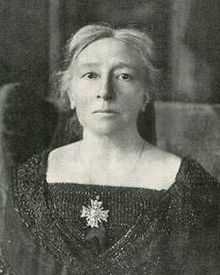Rosie Hackett
| Rosie Hackett | |
|---|---|
 | |
| Born |
Rosanna Hackett 25 July 1892 Dublin, Ireland |
| Died |
1976 Dublin, Ireland |
| Nationality | Irish |
| Occupation | Messenger, printer, cooperative organiser |
Rosanna "Rosie" Hackett (1892 – 1976) was an Irish trade union leader.
Life and career
Rosie Hackett was born into a working class family in Dublin in 1892. The 1901 census shows that she was living with her widowed mother and sister in a tenement building on Bolton Street in the city centre; her father, John Hackett, was a barber who is believed to have died when she was still very young. Hackett worked as first a packer in a paper store and then got a job as a messenger for Jacob's Biscuits, where she became involved in the campaign for improved working conditions while still a teenager.
Active in the Irish Transport and General Workers Union (ITGWU) from its foundation in 1909, and co-founder (with Delia Larkin) of the Irish Women Workers' Union in 1911,[1] she organised the strike of women workers at Dublin's Jacob's biscuit factory in 1911. Fired from her job at the factory because of her trade union involvement, she later worked as a clerk for the ITGWU and trained as a printer.
1916 Rising
Hackett was an active member of the Irish Citizen Army.[2] Along with Constance Markievicz and Michael Mallon, she was part of the small rebel group which occupied Stephen's Green and the Royal College of Surgeons during the 1916 Rising. She used her training as a printer to help with the printing of the first 1916 Proclamation.[3] Following the failure of the rebellion, Hackett was imprisoned in Kilmainham Jail for ten days.
Later Life and Legacy
Rosie Hackett never married and lived with her bachelor brother Tommy in Fairview, Dublin, until her death in 1976 at the age of 84. She was buried in Glasnevin Cemetery, with full military honours.[4]
In 1970, she was awarded a gold medal for giving 60 years of her life to the trade union movement. In 2013, a new bridge over the River Liffey in Dublin was named in her honour; this was the first time that a bridge over the Liffey had been named for a woman.[5]
References
- ↑ Mary McAuliffe and Jeni Gartland (28 August 2013). "A good year to remember Rosie Hackett, a fighter for workers’ and women’s rights". Irish Times. Retrieved 3 September 2013.
- ↑ "Dublin City councillors urged to vote for the Rosie Hackett Bridge". Irish Left Review. 28 August 2013. Retrieved 3 September 2013.
- ↑ "Women's Museum of Ireland". Retrieved 24 November 2013.
- ↑ Hidden Histories w/Turtle Bunbury; The life and times of Rosie Hackett http://www.newstalk.ie/Hidden-Histories-wTurtle-Bunbury-The-life-and-times-of-Rosie-Hackett
|url=missing title (help). Retrieved 24 November 2013. - ↑ "New Liffey bridge to be named after activist Rosie Hackett". RTÉ News. 2 September 2013.